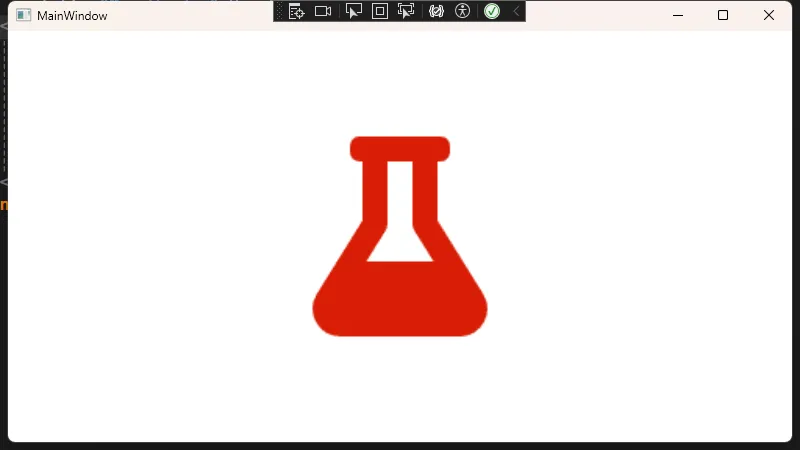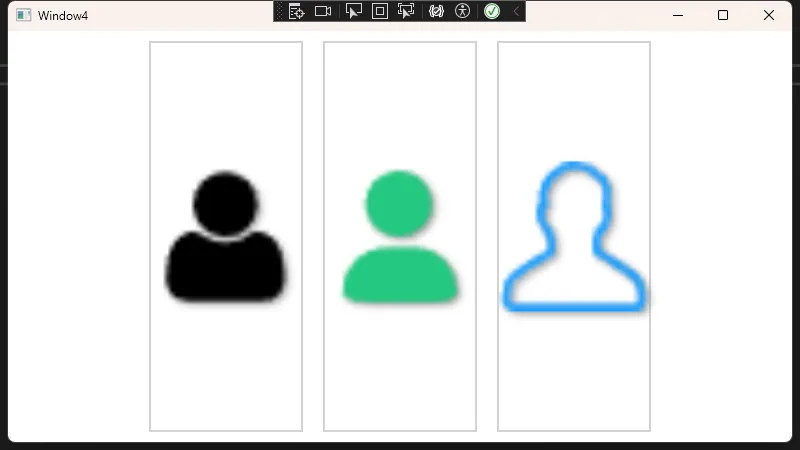目录
从 WinForm 到 WPF 的转换是许多开发者在现代化 UI 需求下的必经之路。WPF(Windows Presentation Foundation)相较于 WinForm 在界面渲染和布局上有更强大的能力,可以更灵活地使用 XAML 来打造界面,真正实现 UI 与业务逻辑分离。下面将重点阐述如何在 WPF 中使用 Image 控件及其样式,以帮助你完成 WinForm 到 WPF 的转型。
基础概念与差异
在 WinForm 中,图片往往使用 PictureBox 控件去展示。在 WPF 中,展示图像的控件是 Image。相比 WinForm 的 PictureBox,Image 控件在布局、绘制机制以及样式化等方面更具弹性。
- WinForm:
PictureBox负责显示图片。- 通过
PictureBoxSizeMode控制缩放和填充,如AutoSize,StretchImage,Zoom等。
- WPF:
Image控件用于显示图片。- 通过
Stretch和StretchDirection属性控制缩放行为。 - 采用 XAML 的方式进行配置,灵活运用绑定和样式资源。
一个简单的 Image 示例
下面的示例展示了在 XAML 中使用 Image 控件,显示一张本地图片并设置最基本的拉伸和排列方式。
XML<Window x:Class="AppImage.MainWindow"
xmlns="http://schemas.microsoft.com/winfx/2006/xaml/presentation"
xmlns:x="http://schemas.microsoft.com/winfx/2006/xaml"
xmlns:d="http://schemas.microsoft.com/expression/blend/2008"
xmlns:mc="http://schemas.openxmlformats.org/markup-compatibility/2006"
xmlns:local="clr-namespace:AppImage"
mc:Ignorable="d"
Title="MainWindow" Height="450" Width="800">
<Grid>
<Image Source="Images/flask.png"
HorizontalAlignment="Center"
VerticalAlignment="Center"
Stretch="Uniform"
Width="200"
Height="200"/>
</Grid>
</Window>

确认图片的属性设置:
- 在解决方案资源管理器中,右键点击flask.png文件
- 确保其"构建操作"设置为"Content"
- 如设置为"Content",还需确保"复制到输出目录"设置为"如果较新则复制"或"始终复制"
在上述示例中:
Source="Images/sample.png":指定要显示的图片路径(可相对,可绝对)。Stretch="Uniform":等比缩放以适应空间,同时保持图片纵横比。
常见的 Image 属性与用法
WPF 中 Image 常用属性主要有:
- Source: 图片源,可以是文件路径、URI 或者
BitmapImage等各种格式。 - Stretch: 图片在控件中的拉伸模式,常见值有:
None:不拉伸。Fill:填充整个区域,可能会导致图片变形。Uniform:在保持图片原有比例的前提下,尽量放大或缩小以适应控件大小。UniformToFill:在保持图片比例的前提下,填满控件并裁剪超出部分。
- StretchDirection: 决定缩放的方向,如
UpOnly,DownOnly或Both。 - Opacity: 控制图片不透明度,值从 0.0(完全透明)到 1.0(完全不透明)。
- RenderTransform: 允许对图片进行旋转、平移或缩放等变化。
在 WinForm 中自定义图像旋转、透明度,大多需要手动编写绘制逻辑或使用 GDI+。而在 WPF 中,可以基于控件的依赖属性和数据绑定进行更灵活的控制。
使用资源(Resource)与绑定(Binding)
在 WPF 中,若要在多个地方共享相同的图片或配置,可以将图片路径或相关样式放入资源中。这样不仅有助于复用,也便于统一管理。
静态资源使用(StaticResource)
假如你需要在多个地方使用同一张图片,可以先在 Window.Resources 或 Application.Resources 中定义一个 BitmapImage 实例,然后用 StaticResource 引用它。
XML<Window x:Class="AppImage.Window1"
xmlns="http://schemas.microsoft.com/winfx/2006/xaml/presentation"
xmlns:x="http://schemas.microsoft.com/winfx/2006/xaml"
xmlns:d="http://schemas.microsoft.com/expression/blend/2008"
xmlns:mc="http://schemas.openxmlformats.org/markup-compatibility/2006"
xmlns:local="clr-namespace:AppImage"
mc:Ignorable="d"
Title="Window1" Height="450" Width="800">
<Window.Resources>
<!-- 定义一个静态资源,引用一张图片 -->
<BitmapImage x:Key="SharedSampleImage" UriSource="Images/flask.png" />
</Window.Resources>
<StackPanel>
<!-- 使用静态资源 -->
<Image Source="{StaticResource SharedSampleImage}"
Height="100" Width="100" Stretch="Uniform" Margin="20" />
<!-- 也可以在同一个窗口中多处引用同一资源 -->
<Image Source="{StaticResource SharedSampleImage}"
Height="100" Width="100" Stretch="Uniform" Margin="20" />
</StackPanel>
</Window>

动态资源使用(DynamicResource)
与 StaticResource 不同,DynamicResource 会在运行时根据资源变化进行更新。若你需要在应用运行过程中动态切换图片或皮肤配置,DynamicResource 通常能带来更灵活的效果。
XML<Image Source="{DynamicResource SharedSampleImage}" />
绑定到属性(Binding)
在某些情况下,你可能需要根据后台逻辑动态显示不同的图片。例如,根据用户选择显示不同图标,这时可以借助数据绑定完成。
XML<Window x:Class="AppImage.Window3"
xmlns="http://schemas.microsoft.com/winfx/2006/xaml/presentation"
xmlns:x="http://schemas.microsoft.com/winfx/2006/xaml"
xmlns:d="http://schemas.microsoft.com/expression/blend/2008"
xmlns:mc="http://schemas.openxmlformats.org/markup-compatibility/2006"
xmlns:local="clr-namespace:AppImage"
mc:Ignorable="d"
Title="Window3" Height="450" Width="800">
<Window.DataContext>
<local:ImageViewModel/>
</Window.DataContext>
<Grid>
<Grid.RowDefinitions>
<RowDefinition Height="Auto"/>
<RowDefinition Height="*"/>
<RowDefinition Height="Auto"/>
</Grid.RowDefinitions>
<TextBlock Grid.Row="0"
Text="动态图片绑定示例"
FontSize="24"
Margin="10"
HorizontalAlignment="Center"/>
<Border Grid.Row="1"
BorderBrush="Gray"
BorderThickness="1"
Margin="20">
<!-- 绑定到SelectedImage属性 -->
<Image Source="{Binding SelectedImage}"
Width="200"
Height="200"
Stretch="Uniform"/>
</Border>
<StackPanel Grid.Row="2"
Orientation="Horizontal"
HorizontalAlignment="Center"
Margin="10">
<Button Content="图片1"
Command="{Binding ChangeImageCommand}"
CommandParameter="/Images/user1.png"
Margin="5"
Padding="10,5"/>
<Button Content="图片2"
Command="{Binding ChangeImageCommand}"
CommandParameter="/Images/user2.png"
Margin="5"
Padding="10,5"/>
<Button Content="图片3"
Command="{Binding ChangeImageCommand}"
CommandParameter="/Images/user3.png"
Margin="5"
Padding="10,5"/>
</StackPanel>
</Grid>
</Window>
C#using System;
using System.Collections.Generic;
using System.ComponentModel;
using System.Diagnostics;
using System.Linq;
using System.Runtime.CompilerServices;
using System.Text;
using System.Threading.Tasks;
using System.Windows.Input;
using System.Windows.Media.Imaging;
namespace AppImage
{
public class ImageViewModel : INotifyPropertyChanged
{
// 移除原来的字符串路径属性,改用BitmapImage
private BitmapImage _selectedImage;
public BitmapImage SelectedImage
{
get { return _selectedImage; }
set
{
_selectedImage = value;
OnPropertyChanged(nameof(SelectedImage));
}
}
// 图片路径列表保持不变
public string[] ImagePaths { get; } = new string[]
{
"/Images/user1.png",
"/Images/user2.png",
"/Images/user3.png"
};
public ICommand ChangeImageCommand { get; }
public ImageViewModel()
{
// 初始化默认图片
LoadImage(ImagePaths[0]);
// 命令实现
ChangeImageCommand = new RelayCommand<string>(LoadImage);
}
// 加载图片的方法
private void LoadImage(string path)
{
Debug.WriteLine($"正在加载图片: {path}");
try
{
// 创建新的BitmapImage实例
var newImage = new BitmapImage();
newImage.BeginInit();
newImage.CacheOption = BitmapCacheOption.OnLoad; // 强制重新加载
newImage.CreateOptions = BitmapCreateOptions.IgnoreImageCache; // 忽略缓存
newImage.UriSource = new Uri(path, UriKind.RelativeOrAbsolute);
newImage.EndInit();
// 更新UI绑定的图片
SelectedImage = newImage;
Debug.WriteLine("图片加载成功");
}
catch (Exception ex)
{
Debug.WriteLine($"图片加载失败: {ex.Message}");
}
}
public event PropertyChangedEventHandler PropertyChanged;
protected void OnPropertyChanged([CallerMemberName] string propertyName = null)
{
PropertyChanged?.Invoke(this, new PropertyChangedEventArgs(propertyName));
}
}
}
C#using System;
using System.Collections.Generic;
using System.Linq;
using System.Text;
using System.Threading.Tasks;
using System.Windows.Input;
namespace AppImage
{
public class RelayCommand<T> : ICommand
{
private readonly Action<T> _execute;
private readonly Func<T, bool> _canExecute;
public RelayCommand(Action<T> execute, Func<T, bool> canExecute = null)
{
_execute = execute ?? throw new ArgumentNullException(nameof(execute));
_canExecute = canExecute;
}
public bool CanExecute(object parameter)
{
return _canExecute == null || _canExecute((T)parameter);
}
public void Execute(object parameter)
{
_execute((T)parameter);
}
public event EventHandler CanExecuteChanged
{
add { CommandManager.RequerySuggested += value; }
remove { CommandManager.RequerySuggested -= value; }
}
}
}

只需在后台 ViewModel 修改 SelectedImagePath 属性,前端 Image 控件就会自动更新图片。
Image 样式(Style)案例
WPF 的强大之处之一在于可以通过样式(Style)对控件进行统一的外观控制。下面展示一个通过 Style 改变 Image 控件的边框、阴影等视觉效果的示例。
XML<Window x:Class="AppImage.Window4"
xmlns="http://schemas.microsoft.com/winfx/2006/xaml/presentation"
xmlns:x="http://schemas.microsoft.com/winfx/2006/xaml"
xmlns:d="http://schemas.microsoft.com/expression/blend/2008"
xmlns:mc="http://schemas.openxmlformats.org/markup-compatibility/2006"
xmlns:local="clr-namespace:AppImage"
mc:Ignorable="d"
Title="Window4" Height="450" Width="800">
<Window.Resources>
<!-- 定义Image控件的自定义样式 -->
<Style TargetType="Image" x:Key="FancyImageStyle">
<Setter Property="Stretch" Value="Uniform" />
<Setter Property="Width" Value="150" />
<Setter Property="Height" Value="150" />
<Setter Property="Margin" Value="10" />
<Setter Property="Effect">
<Setter.Value>
<!-- 让图片带阴影效果 -->
<DropShadowEffect ShadowDepth="5"
BlurRadius="10"
Direction="320"
Color="Gray"
Opacity="0.5" />
</Setter.Value>
</Setter>
</Style>
</Window.Resources>
<Grid>
<StackPanel Orientation="Horizontal" HorizontalAlignment="Center">
<Border BorderBrush="LightGray" BorderThickness="2" Margin="10">
<Image Source="Images/user1.png" Style="{StaticResource FancyImageStyle}" Margin="0"/>
</Border>
<Border BorderBrush="LightGray" BorderThickness="2" Margin="10">
<Image Source="Images/user2.png" Style="{StaticResource FancyImageStyle}" Margin="0"/>
</Border>
<Border BorderBrush="LightGray" BorderThickness="2" Margin="10">
<Image Source="Images/user3.png" Style="{StaticResource FancyImageStyle}" Margin="0"/>
</Border>
</StackPanel>
</Grid>
</Window>

在这个示例中:
- 无需在每一个
Image控件上手动设置这些属性,从而大大提升了可维护性。
动态效果:鼠标悬停放大
WPF 中也可以通过 Triggers 或者动画(Storyboard)制作简单的动态效果。下面通过 Triggers 让鼠标悬停时图片放大并带有轻微动画。
XML<Window x:Class="AppImage.Window5"
xmlns="http://schemas.microsoft.com/winfx/2006/xaml/presentation"
xmlns:x="http://schemas.microsoft.com/winfx/2006/xaml"
xmlns:d="http://schemas.microsoft.com/expression/blend/2008"
xmlns:mc="http://schemas.openxmlformats.org/markup-compatibility/2006"
xmlns:local="clr-namespace:AppImage"
mc:Ignorable="d"
Title="Window5" Height="450" Width="800">
<Window.Resources>
<Style x:Key="HoverEnlargeImage" TargetType="Image">
<Setter Property="RenderTransformOrigin" Value="0.5, 0.5"/>
<Setter Property="RenderTransform">
<Setter.Value>
<!-- 初始无缩放 -->
<ScaleTransform ScaleX="1" ScaleY="1"/>
</Setter.Value>
</Setter>
<Style.Triggers>
<Trigger Property="IsMouseOver" Value="True">
<Trigger.EnterActions>
<BeginStoryboard>
<Storyboard>
<!-- 鼠标进入后放大到1.2倍 -->
<DoubleAnimation Storyboard.TargetProperty="RenderTransform.ScaleX"
To="1.2" Duration="0:0:0.2"/>
<DoubleAnimation Storyboard.TargetProperty="RenderTransform.ScaleY"
To="1.2" Duration="0:0:0.2"/>
</Storyboard>
</BeginStoryboard>
</Trigger.EnterActions>
<Trigger.ExitActions>
<BeginStoryboard>
<Storyboard>
<!-- 鼠标离开后回到原尺寸 -->
<DoubleAnimation Storyboard.TargetProperty="RenderTransform.ScaleX"
To="1" Duration="0:0:0.2"/>
<DoubleAnimation Storyboard.TargetProperty="RenderTransform.ScaleY"
To="1" Duration="0:0:0.2"/>
</Storyboard>
</BeginStoryboard>
</Trigger.ExitActions>
</Trigger>
</Style.Triggers>
</Style>
</Window.Resources>
<Grid>
<Image Source="Images/flask.png"
Width="200"
Height="200"
Style="{StaticResource HoverEnlargeImage}"/>
</Grid>
</Window>

通过这种方式,你可以在不编写任何后台代码的情况下让 Image 根据鼠标悬停产生动画。
总结
- WPF 提供了更灵活的布局和样式系统,相比 WinForm 有更先进的图形渲染机制。
Image控件能通过Stretch,StretchDirection等属性灵活控制图像展示方式,与 WinForm 的PictureBox基本功能相当,但具备丰富的样式和动画优势。- 通过 XAML 资源和样式,可以轻松地统一管理界面中多处使用的图片外观与行为。
- 触发器(Triggers)和动画(Storyboard)能够带来现代化的交互体验,让应用 UI 更加生动。
从 WinForm 转向 WPF,不单单是控件名称上的变化,更是开发思维与设计理念的转变。希望上述示例能够帮助你快速理解并上手使用 WPF 中的 Image 控件,为你的应用打造更出色的 UI 和交互。
本文作者:技术老小子
本文链接:
版权声明:本博客所有文章除特别声明外,均采用 BY-NC-SA 许可协议。转载请注明出处!